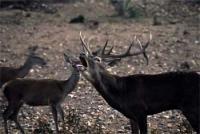
Roaring male Iberian red deer with females (photograph by Juan Carranza) In the September issue of The American Naturalist, Juan Carranza (Biology and Ethology Unit, University of Extremadura, Spain) and Javier Pérez-Barbería (Macaulay Institute, United Kingdom) offer a new explanation for why males of ungulate species subjected to intense competition are born with lower survival expectancies than females. The research reveals that male ungulates have smaller molars relative to their body size – and hence less durable teeth that will wear out sooner, which might contribute to their shorter lives compared with females.
Natural selection favors reproduction rather than survival; the cost of reproduction compromises survival. Males of species subjected to intense male-male competition for access to females are known to have shorter life expectancies than females. Earlier aging in males might be related to higher reproductive costs, especially when lifetime reproductive success in males takes place within the few years when they can win contests and maintain their dominance.
By comparing body and dental size of males and females of 123 species of ungulates, the authors offer another compelling explanation for why male ungulates lead shorter lives. They estimated the pattern of change of these traits along the evolutionary development of the group and found that for species where a single male has many females and where the males and females are different sizes, the rate of increase of dental size was lower than that of body size. As a result, smaller teeth (in comparison to body size) are produced in males. It is possible that natural selection did not produce larger, more durable teeth because there was no reproductive return from it, since males in these species do not generally increase their success by living longer after prime age.
“These findings,” the authors state, “provide us with interesting insights into how natural and sexual selection design our bodies and their longevity.” Source : University of Chicago Press Journals
 Print Article
Print Article Mail to a Friend
Mail to a Friend
